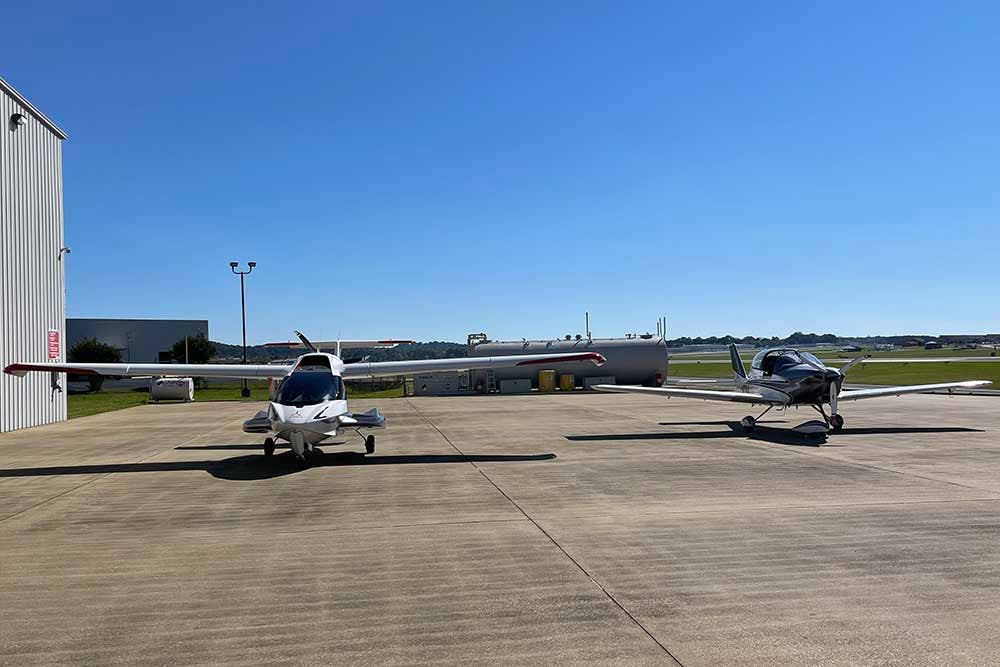
Craig Fuller’s ICON A5 (left) and Tecnam Astore. [Courtesy: Craig Fuller]
After earning his private pilot certificate and flying Cessna 172s, FLYING’s owner and CEO Craig Fuller “did the math” and discovered what many buyers also learn—that it was just not possible to find one perfect airplane to serve him for every desired mission. He wanted something fun for pure recreational flying, but also something that would be a comfortable cross-country airplane with advanced avionics and an autopilot.
After a great deal of due diligence, Fuller chose the Icon A5 amphibian as his “fun” light sport airplane, and a Tecnam Astore as his cross-country LSA.
“I actually calculated it all out,” Fuller said. “And with the money I have into my two LSAs, it was still cheaper than a new Cessna 172 or Cirrus SR20. Sure, I am giving up a little power and speed, but now I have two airplanes that serve all of my personal flying needs.”
"You get quality one-on-one time with just one other person, you get to have an adventure, and it doesn’t cost all that much to do.”
FLYING CEO Craig Fuller on the benefits of flying LSAs
The one airplane not worked into those calculations is Fuller’s 1/10th ownership in a HondaJet through the Jet-It program.
“I was flying commercial four days a week with Diamond and Platinum status,” he said, “and when COVID hit, I switched to trying to do business virtually. But when I do need to travel for business now, I use charter or the HondaJet.”
The Economics of Flying Light-Sport
Like all owners, Fuller enjoys great fuel economy with his two LSAs. Both the Icon A5 and Tecnam Astore fly behind Rotax engines, with the A5 seeing about 5.5 gph fuel burn, according to Fuller.
“If you are doing touch-and-goes off the water, naturally, that number rises slightly, but still, it only costs about $30 an hour for fuel,” he said. His Astore burns about 6.5 to 7 gph with its Rotax 914 turbocharged engine.
“When you think about it, I can do 120 knots all day in my Tecnam, and it’s just a little slower than a new 172 or SR20,” Fuller says. “If you are not going super long distances, the Astore makes a solid cross-country platform. It is comfortable, has very good avionics, and a great autopilot. I can get around easily in it and only spend about $40 an hour for fuel.”
Mission Capable
When Fuller wants to just have some fun in the air, he flies his Icon A5 around his Chattanooga, Tennessee, home.
“I bought the Icon A5 first, and with 85 knots of cruise speed, it is not a very good cross-country airplane,” Fuller explains. “I love to fly it around the mountains of Tennessee, and it can land on almost any body of water as long as I have enough space. It’s great to take the windows out when the weather is good and that makes it feel sort of like driving a convertible car in the air.
“One of the things I love to do in the A5 when there are no obstructions is take off from a waterway and stay about 200 feet above the water flying up through the mountains. It has a very Star Wars feel to it. Plus, with the river right below you, you effectively have a runway in case you need to ditch or have a problem.”
The Astore on the other hand offers Fuller a full Garmin G3X suite panel which makes the Tecnam his choice when he wants to go somewhere.
“Once I took delivery of the Astore, I fell in love with the G3X panel. The [SiriusXM] weather has been great to get real-time weather updates, and it is just a very advanced airplane. The autopilot allows me to manage the airplane well, and I can sort of relax in it,” Fuller says.
“I learned on six-pack 172s, so I am really enjoying flying with some of the most advanced general aviation avionics available today.”
A Realized Benefit
Fuller considered buying a larger airplane that could carry all seven people in his family, and realized not even a new Cirrus SR22 could do that. With his two LSAs built to each carry the pilot and only one passenger, he has discovered a benefit that many people might not think about when considering a light sport airplane.
“I have five kids,” Fuller said, “and with either of the two LSAs, I can only take one of them up at a time. So I get some distraction-free time with each of them—no internet, no devices. There is just something really powerful about that experience. This is something many people probably do not consider about LSAs. You get quality one-on-one time with just one other person, you get to have an adventure, and it doesn’t cost all that much to do.”
Fuller is “all-in” on light sport airplanes, and he will soon replace his Icon with a new A5, to be delivered this spring. His point that owning two LSAs is still more economical than one high-performance airplane is backed up by numbers. Fuller has become a successful businessman because he is a “data guy” and the growth of FLYING and his other major venture, FreightWaves, proves he can crunch the numbers and make good decisions. For now, the “two LSAs” model is serving him well to fly varying missions, and that is unlikely to change any time soon.

Sign-up for newsletters & special offers!
Get the latest FLYING stories & special offers delivered directly to your inbox






